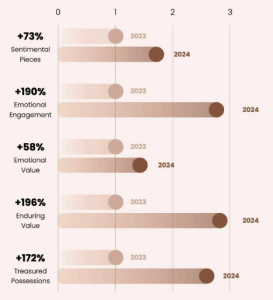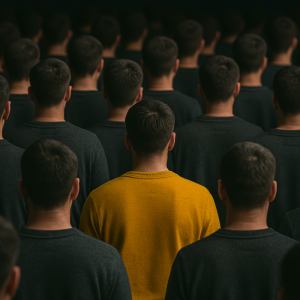Balancing Reality

Key Takeaway:
Consumers are prioritizing real-world, meaningful experiences—not by rejecting technology, but by integrating it intentionally alongside physical connections and community-driven interactions. The resurgence of offline activities, the return to in-store shopping, and the embrace of analog culture reflect a collective push for balance. Businesses that harmonize digital and physical experiences—leveraging AI while maintaining authenticity—will be best positioned to meet evolving expectations. Trust, connection, and authenticity remain central themes, defining the future of consumer and brand relationships in a hyperconnected era.
Trend Type: Social & Business
Sub-trends: Social Rewilding, Experience Economy, In-Person's Events Creativity, Mindful Approach to Tech, AI-Authenticity Balance, Togetherness Deficit, Power In Niches, Peer-to-Peer Recommendations.
Rebalancing Digital and Physical Life
This trend has been unfolding since the Covid era, when people rediscovered nature, in-person socialization, and tangible connections. In sum, as digital saturation grows, people are seeking deeper, real-world experiences to restore balance. Rather than rejecting technology, they are redefining their relationship with it—prioritizing face-to-face interactions, sensory engagement, and offline activities. Accenture’s global survey found that 42% of respondents said their most enjoyable recent experience was physical, while only 15% cited digital experiences. And nearly half embraced JOMO (Joy of Missing Out), reducing screen time in favor of real-life experiences like reading physical books.
This return to physical experiences is evident in fitness and wellness. Running clubs, outdoor workouts, and social prescribing—where doctors recommend group activities for mental health—are on the rise. Brandwatch Consumer Research found that mentions of run clubs grew 52% between April and September 2024. In dating dynamics, the culture is shifting too: 79% of Gen Z prefer meeting in person over dating apps, according to Fortune, with 62% dating offline more frequently over the past year.
Further examples of this trend, include how retail habits are also changing, with consumers returning to in-store shopping for sensory engagement. A Nextatlas study found that most global consumers believe brands should activate all their senses. Similarly, EY’s 2024 Future Index Study, surveying more that twenty three thousand consumers across thirty countries, revealed 57% prefer to see, touch, and feel products before purchasing, and 68% seek expert advice on high-value items. Additionally, 61% visit stores for promotions unavailable online, reinforcing the value of physical shopping.
Nostalgia for the pre-digital era fuels this shift. Gen Z and Millennials romanticize the ‘90s and early 2000s, reviving vinyl records, disposable cameras, and dumbphones. Brandwatch’s 2024 survey found most marketers expect a shift toward mindful social media use and analog lifestyles in 2025. Consumer sentimentality is influencing purchasing decisions, a trend known as “Sentimental Inflation.” Classic cars from the ’80s and ’90s are gaining popularity as drivers seek a more engaging experience over modern, tech-heavy vehicles.

Source: NextAtlas - YOY Global Consumer Values Growth, 2024
The Search for Community and Connection
The pandemic accelerated a global loneliness epidemic, as highlighted in WHO’s 2024 report. In China, a “friendship recession” is emerging, with young people reporting an average of just 2.5 close friends (Soul via Jing Daily, 2024). Traditional ways of connecting, like watching sports together, are shifting to virtual spaces, raising concerns about long-term social cohesion. A 2024 Brandwatch survey found that over 60% of marketers view live experiences as a major trend for 2025, recognizing their ability to foster exclusivity, urgency, and shared excitement.
Brands are reviving sociologist Ray Oldenburg’s concept of “third places”—social spaces distinct from home and work—to encourage spontaneous interaction. Consumers are moving away from car-dependent suburbs and rigid social structures, seeking flexible environments where organic communities can thrive.
Both digital and physical communities are gaining new importance. From local running clubs to intimate lectures and hobby-based meetups, people are seeking shared experiences that foster real connection. Trendhunter’s 2024 global survey found that 44% of marketers see community-building beyond social media as a major trend for 2025. Private online groups, exclusive mailing lists, and podcast communities are growing as brands bypass algorithms to build deeper, more authentic relationships.
The Role of AI and Authenticity in Consumer Trust
AI is becoming dominant in marketing, but balancing automation with authenticity is a challenge. Brandwatch’s global survey found 71% of marketers view maintaining the human touch while leveraging AI as a key concern for 2025. Consumers are wary of AI-generated interactions, particularly in customer service and creative fields. The challenge for marketers is harnessing AI’s efficiency without losing personal connection—reinforcing the broader demand for authenticity, trust, and connection in an AI-driven world.
Trust in AI-generated content is declining, making peer-to-peer recommendations more influential. Brandwatch’s survey found 45% of marketers believe consumer-driven recommendations will shape purchasing decisions in 2025 (refer to “Ambivalent Reality” trend for more). Brands are responding by investing in user-generated content (UGC) and employee-generated content (EGC) to build credibility. Meanwhile, TikTok’s deinfluencing trend is growing, with consumers rejecting aggressive marketing in favor of mindful consumption—seeking cheaper alternatives and embracing the “buy less, buy better” philosophy.
On the other hand, regarding AGI – the AI that possesses the ability to understand, learn, and perform any intellectual task a human being can accomplish – the uncertainty relates to questions about the nature of intelligence and the human brain’s capabilities, as there might be an upper bound to the complexity of tasks the human brain can perform and the brain’s ability to transmit information to other intelligent entities (humans or AI) is limited by the slow speed of information transmission of our senses and our language. Therefore, what is beyond our comprehension is unpredictable.
Use Cases
Experience Economy: Coinciding with Shanghai Fashion Week in October 2024, luxury outerwear brand Moncler hosted a spectacle which “scrambled the senses,”according to Vogue. The City of Genius brought together 10 cocreators from the worlds of design, art, and music in a vast series of immersive events. Taking place in a 30,000-square-meter shipyard on the banks of the Huangpu River, it featured rain, sand, snow, willow trees, and orange groves, which enveloped visitors in a citrus mist. The 10 “neighborhoods” included Vogue’s global creative and cultural advisor Edward Enninful’s extreme weather station—a multisensory experience of extreme conditions, including a “heat-showered sand dune and a mammoth iceberg.”
In-Person’s Events Creativity: Movie theaters are adding sensory layers to the viewing experience. Alamo Drafthouse joined forces with Joya fragrance studio, using its atomization technology to resurrect “smell-o-vision” for screenings of A24’s Heretic, in which a key plot point revolves around the scent of blueberry pie. At a key juncture in the movie, auditoria were filled with the scent of the dessert. The 4DX immersive theatrical format broke box office records in 2024 as cinemagoers sought out full-body viewing. Screenings included Twisters, which treated audiences to tornado-like wind and rain.
Ai Authenticity Balance: Taking a traditional lens on beauty is the first Miss AI competition, launched in spring 2024. Judging was shaped by three criteria, the first being beauty, with contestants assessed on “the classic aspects of pageantry including their beauty, poise, and their unique answers to a series of questions,” explains the Miss AI site. The second is tech, in particular the innovative use of AI; the third is social clout. Moroccan AI influencer Kenza Layli was crowned the winner in July, followed by Lalina from France and Olivia C from Portugal.
Togertherness Deficit: Dating app Bumble connects members offline has expanded its services to include Bumble IRL, offering in-person mixers and exclusive celebrity events. For example, the brand’s pop-up in Paris offered local members a way to meet – plus they partnered with a local coffee brand to make it happen.
Use Cases
Sub-Trend Sources
Social Rewilding: Accenture Life Trends
Experience Economy: Adobe Creative Trends, NextAtlas Consumer Trends
In-Person's Events Creativity: Brandwatch Digital Marketing Trends
Mindful Approach to Tech: Brandwatch Digital Marketing Trends, VML The Future 100
AI-Authenticity Balance: Brandwatch Digital Marketing Trends
Togetherness Deficit: Dentsu Creative Trends, Trend Hunter
Power In Niches: Brandwatch Digital Marketing Trends, Dentsu Creative Trends, Delloite TMT Predictions, Mintel Consumer Trends, VML The Future 100
Peer-to-Peer Recommendations: Brandwatch Digital Marketing Trends
What to Read Next
Ambivalent Reality
The Erosion of Digital Trust As generative AI becomes more embedded in everyday life, trust in digital spaces is eroding. The ease with which content can be generated and manipulated[...]
Sameness
Sameness in the Algorithmic Age In a world where everything is optimized, everything starts to look the same. The rise of algorithmically driven platforms has accelerated the convergence of aesthetics,[...]
Ways of Work
Workplace Culture and Employee Experience Workplace culture, employee engagement, and leadership approaches are evolving in response to economic pressures, technological advancements, and shifting employee expectations. However, these changes are not[...]
What to Read Next
Ambivalent Reality
The Erosion of Digital Trust As generative AI becomes more embedded in everyday life, trust in digital spaces is eroding. The ease with which content[...]
Sameness
Sameness in the Algorithmic Age In a world where everything is optimized, everything starts to look the same. The rise of algorithmically driven platforms has[...]
Ways of Work
Workplace Culture and Employee Experience Workplace culture, employee engagement, and leadership approaches are evolving in response to economic pressures, technological advancements, and shifting employee expectations.[...]


